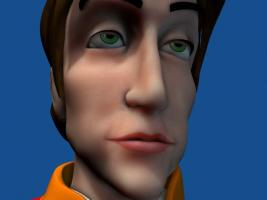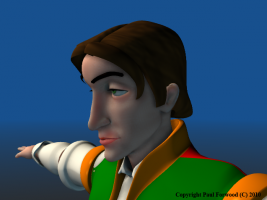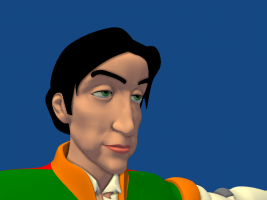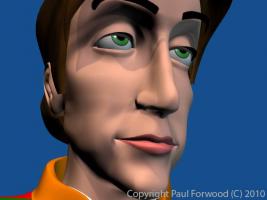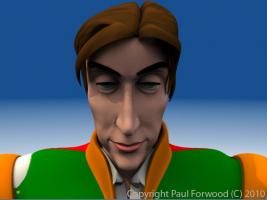-
Posts
5,112 -
Joined
-
Last visited
Content Type
Profiles
Forums
Events
Everything posted by Paul Forwood
-
Here is an example using FakeAO, SSS, Raytraced shadows, Colour map and Bump map. The bump map runs the full scope from back to white and is applied at 100%: FakeAO_SSS_RTShadows_Col_Bmp_100_a.mov The maps are just quick and rough for testing purposes. What looks like freckles were actually meant as a test for pours but the darkening, caused by the SSS, makes them too dark for the purpose. I will experiment on some basic geometry to find a mix of SSS and bump map that suits my needs. The colour map is very understated. Hmmm. I guess that I should up-res the maps.
-
Thank you, Mark and David. Next I'll add some textures.
-
Thanks, Rodney, FakeAO, SSS, 3 point lighting, shadows ON: With raytraced shadows: FakeAO_Test_A00__SSS3pntLights_Shadows.mov With Z-buffered shadows: FakeAO_SSS_Test_A00_Shadows02.mov
-
I tried to render with RealAO and SSS but the skin rendered black. I wasn't able to get them to work together. FakeAO and SSS work so well together so far. Changing the lighting affects the render time. This is one frame of the same sequence that is rendering at 1 min: 25 secs per frame which is not bad, considering that my PC is slow by today's standards, but it is much longer than the previous 4 seconds per frame that I was getting. (Maybe I misread those results). Shadows are turned OFF in this example: FakeAO_Test_A00__SSS3pntLights_09.mov I think I am going to love this new rendering option.
-
Well done, Mark. You must have quite a collection of these reindeer cards now. Merry Christmas. Fill it full of music.
-
Please refer to the image above, Nancy. Lighting definitely has an impact but I haven't experimented with size. I would think that the more screen space that the SSS occupies the longer the render time, but I don't know if a 10 cm sphere renders any faster than a 10 metre sphere. I think it is all down to screen space, pixels. You only calculate what will be seen... I think. Yes. Well last time I tried, (Clint Eastwood model), you could. SSS has a smoothing effect, not unlike the porcelein material, so bumpmaps tend to get a bit washed out. As I recall, displacement with SSS did work but can be a bit messy. Probably just needs to be used judiciously and with careful planning. I should try it again with A:M16. I simply create a group called "Skin", which contains a selection of all the geometry that represents skin and then set the SSS properties in that group's surface properties. Yes, heirarchy matters. I don't know, Robert. I was going to set that one up to run overnight.
-
Here is a comparison of RealAO, FakeAO with SSS and No AO or SSS: I forgot to add the average render times which were approximately: 4 seconds per frame for FakeAO with SSS 6 minutes per frame for RealAO without SSS This is the RealAO example: AM16_RealAO_Test_A00.mov The two versions of AO both have qualities that I like and qualities that I dislike. The standard render still wins but I'll see what I think after the texture maps are added to the mix. I'm impressed by the speed of FakeAO and SSS! Has Steffen been tweaking SSS recently or did I just get lucky with that render?
-
FakeAO with SSS and 3 point lighting: FakeAO_Test_A00_Render2QT_sssAndAllLights_01.mov Average render time: about 4 seconds (I forgot to check after the render finished but I noted that it was around 4 seconds at about 75% rendered). Not bad. A few little tweaks to the model would sort out the strangeness, like his left lower eyelid. Better than expected! Well done, Jenpy!
-
I wanted to try Subsurface scattering with FakeAO. This is what I got: FakeAO_Test_A00_Render2QT_sss_01.mov I only had one klieg light, set to 50%, in this sequence. Turning on the other two lights brings the skin tones back to where they started but washes out the AO. It's a balancing trick. Rendering examples at the moment.
-
Nice work, jimd.
-
Oops! 264 not 263! That's what I meant. I ended up starting a new project before I got FakeAO working but I suspect that had I used the correct compression settings in the first place it might have worked as it was. Don't know though. Thanks, Gene! I wanted to add a touch of Disney to him so he has slightly exaggerated proportions.
-
Looking and sounding great guys! Are you still working on some of those static sequences or is this a rap? You keep raising your bar, Gene.
-
That is weird! What compression did you use in your QT movie, Nancy? I was using mpeg because I had been experiencing problems with H263 recently, thoughthat was probably not with A:M16. I have just started a render with h263 compression and it is actually rendering correctly, as far as I can tell, to the QT movie format. I note that it is not possible to access the depth buffer settings in QT mode as you can when rendering to a still image format. Maybe it is neccessary to set a render up for stills first and then change to QT? Anyway it is working now so I will press on. Thanks, Nancy. Not Shakespeare, though I can see that these recent models would fit the period quite well...at the moment. I did start a model of Shakespeare a few years ago but, alas, (poor Yorik), he remains nothing more than a head. This will be more 30's sci-fi. Think "Saviour of the universe"! (No, Still not Jesus).
-
FakeAO_Test_A00_qt.mov Much better! One klieg light at 50% AI = 50% AO = 0% FakeAO = all default values except Focal Length, which I set to match the camera's focal length. Rendered 3 passes to png format. I'm still not sure that I will be using FakeAO for animation, even though the average render time for this sequence was only about 4 seconds per frame. I look forward to seeing what others produce with the full version and in the meantime I will keep experimenting.
-
Thanks Nancy and Robert. I have tried your suggestions and dozens of other configurations but I just get the same results. I am thinking that my models might be a little too low on patches to get the required results out of FakeAO. -------------------- Edit: I found the problem! I was trying to render to QT rather than an image sequence. I will test a bit more now and post my results.
-
Thanks, Robert. First buffer is set to depth and second is set to color but I'm just getting similar results to that last image. I really like the effect that real AO produces but would need to find a way of preserving the highlights and reflections on shiney surfaces, preferably without compositing. I'll try messing about with FastAO again tomorrow.
-
-
Another character in progress: AM16_Barin_C01i.mov I've just started a test render with SlowAO and one klieg light. This is the first frame: A few frames with AO: AM16_Barin_C01i_AO.mov They were taking over 6 minutes per frame with 3 passes which is too long for an impatient guy like me so I will see what FakeAO can do. I haven't tried it yet.
-

New Childrens Video Finally Completed
Paul Forwood replied to detbear's topic in Work In Progress / Sweatbox
Looks like fun. Congratulations! -
Lots of cool looking stuff going on in Spleenville!
-
Superb character, Nancy! Regarding the whiskers: You could break the chain of whisker bones so that there are just a couple of bones at the end which you can apply a dynamic constraint to. That way you keep control of most of the length of each whisker but allow the dynamics to look after the tips.
-
Oops! (Double post)
-
A flash of light from each explosion at the start of it's sequence and fading out each explosion as it gets smaller might help. I haven't experimented much with explosions in space but I'm sure that there are plenty of examples to aspire to on youtube. On viewing your video again I am even more impressed!
-
-
I would like to see is better explosions but overall this is very well done, especially for a weekend job! .











